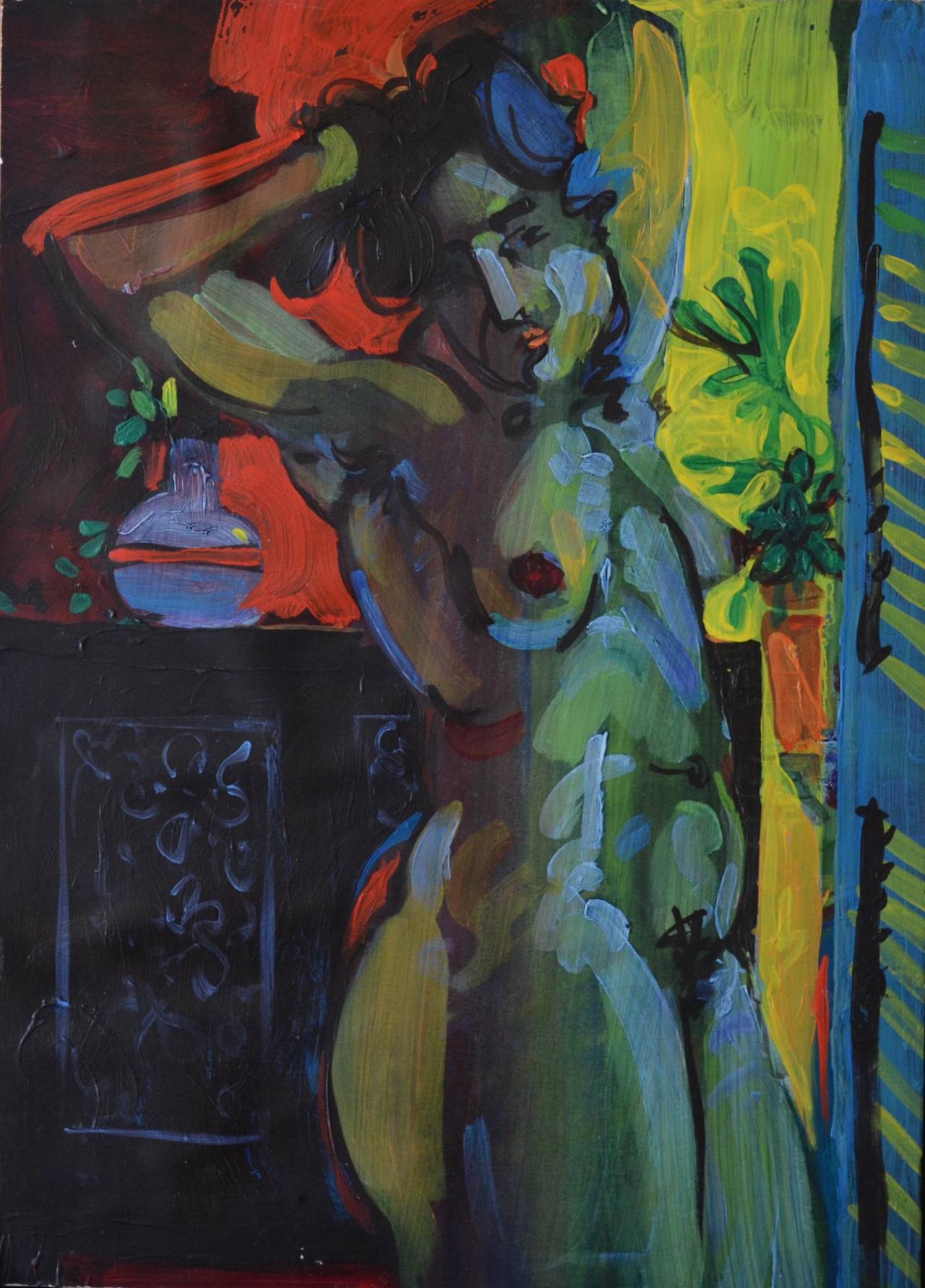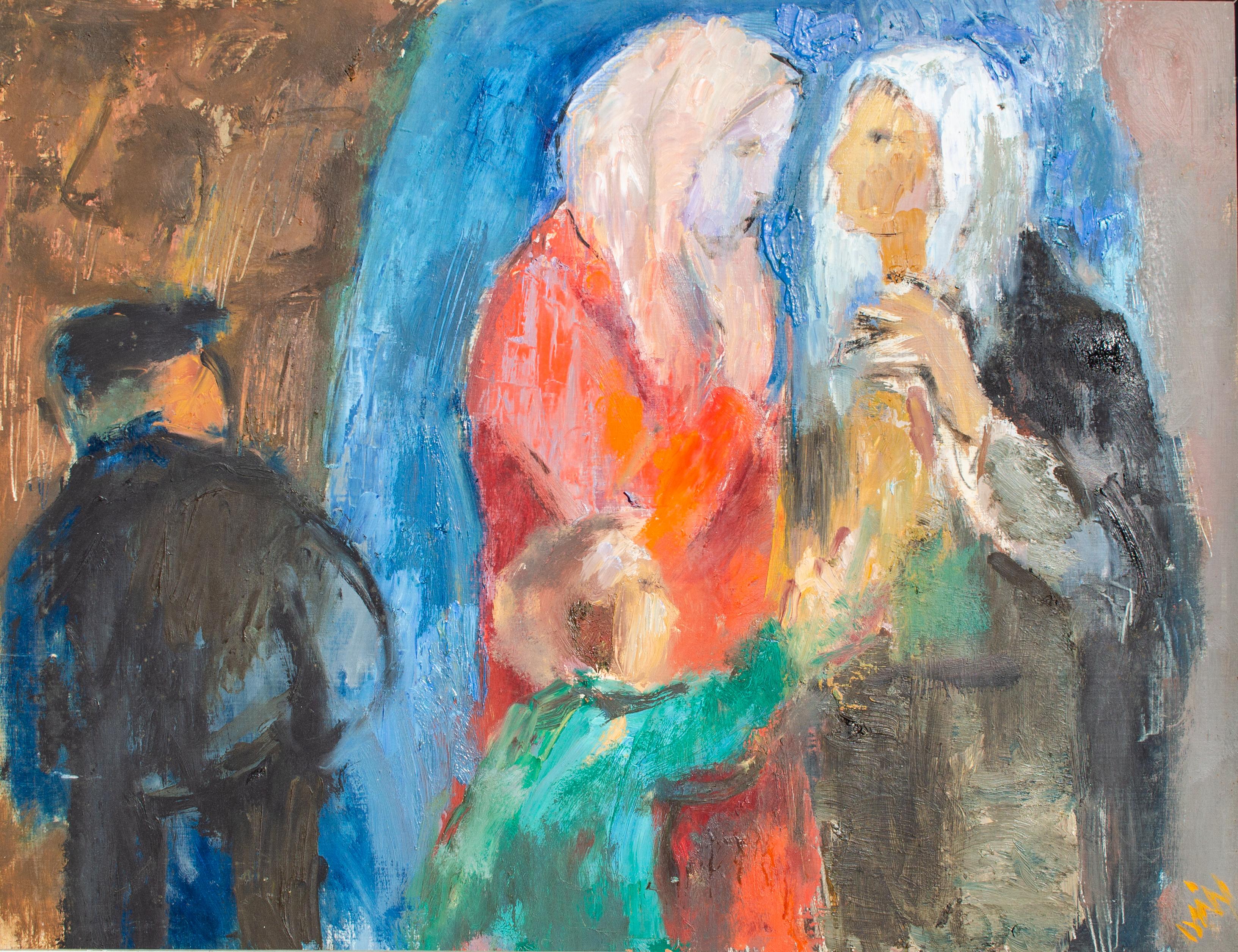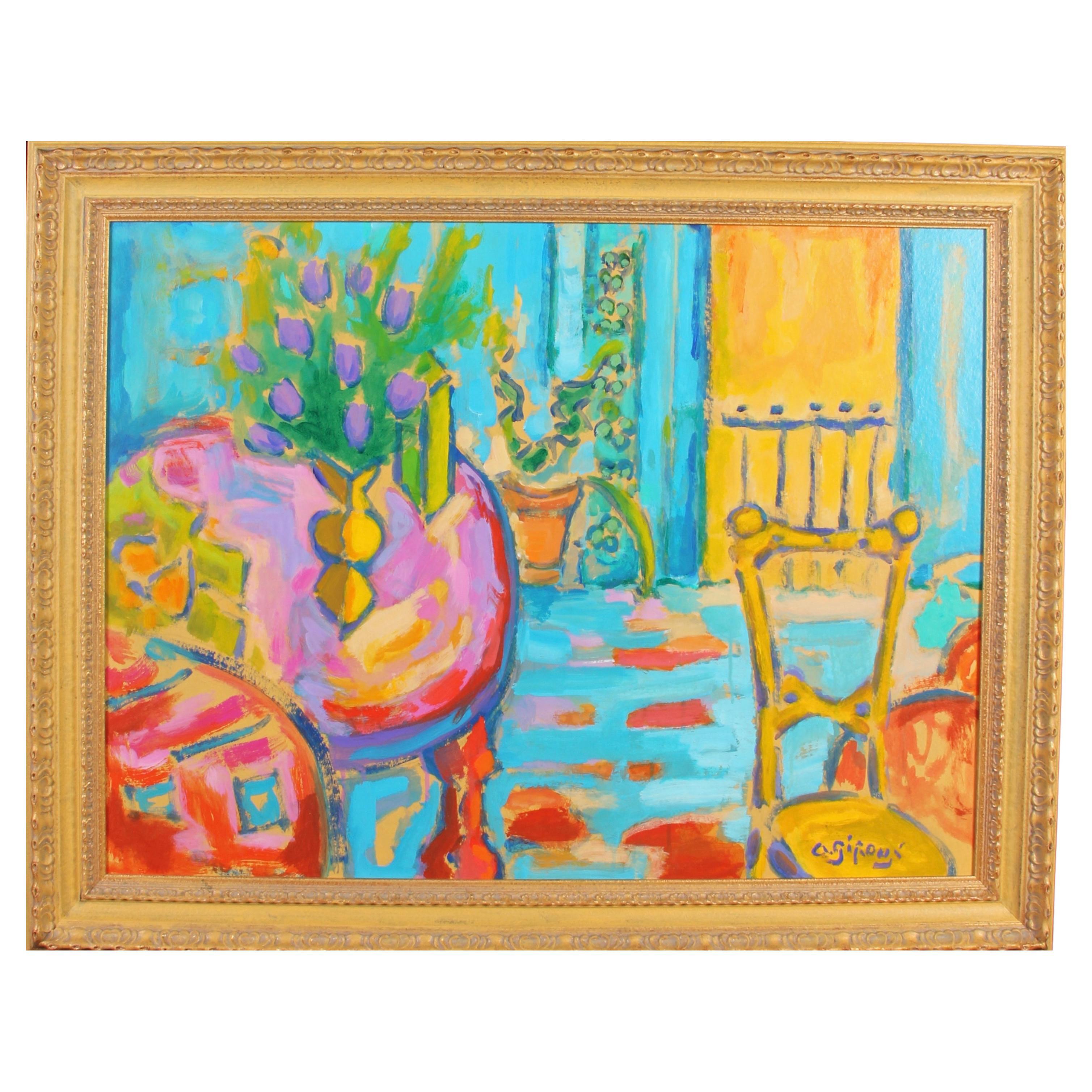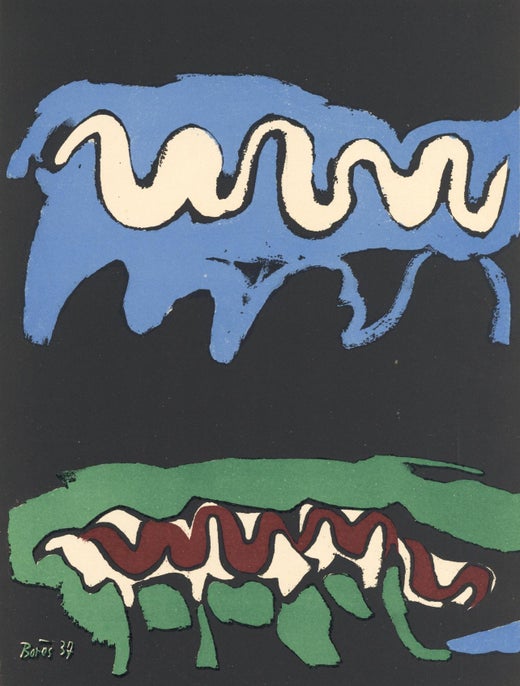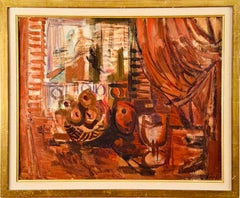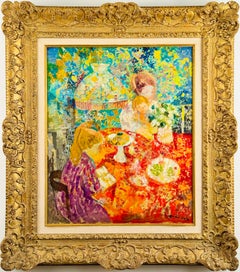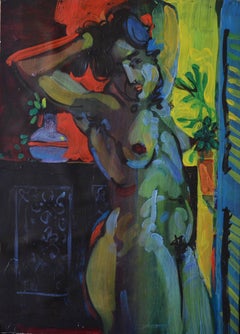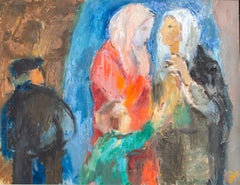Want more images or videos?
Request additional images or videos from the seller
1 of 10
Francisco BoresFrancisco Bores, Sans titre1942
1942
$8,300.50
£6,167.94
€7,000
CA$11,488.38
A$12,793.23
CHF 6,679.64
MX$155,013.70
NOK 84,237.29
SEK 79,484.52
DKK 53,299.26
About the Item
FRANCISCO BORES
Spanish, 1898 - 1972
SANS TITRE
signed and dated "Borès 42" (lower left)
oil on panel
13-3/4 x 10-5/8 inches (35 x 27 cm.)
framed: 19 x 15-3/4 inches (48 x 40 cm.)
BIBLIOGRAPHY:
Francisco Bores, Reasoned Catalogue, Volume I - Painting 1917-1944, Museo Nacional Centro de Arte Reina Sofía, Madrid, 2003, nº 1942 / 63, reproduced in p. 494
PROVENANCE
Carmen Bores Collection, Francisco Bores daughter
Private Collection, Madrid
Francisco Bores López (Madrid, May 5, 1898 - Paris, May 10, 1972) was a Spanish painter of the so-called New School of Paris.
His artistic training originated both in the Cecilio Pla painting academy, where he met Pancho Cossío, Manuel Ángeles Ortiz or Joaquín Peinado, and in the literary gatherings in Madrid related to ultraism.
At this time he made engravings and woodcuts for a large number of magazines such as Horizonte, Cruz y Raya, Index, Revista de Occidente. In 1922 he participated in the National Exhibition of Fine Arts.
In 1925 he participated in the first exhibition of the Iberian Artists Society. The limited success of this exhibition pushes him to go to Paris. In this city he shared a studio with the Spanish painter Pancho Cossío and also met Picasso and Juan Gris.
In 1927 he held his first solo exhibition in Paris. From this moment on, Bores integrates himself into the Parisian artistic environment where he will live practically his entire life. In 1928, his first exhibition in a gallery in the United States, in 1930 he exhibited again, within a group exhibition at the Museum of Modern Art in New York.
In the following years, he continued exhibiting in different galleries in Paris, such as the Georges Petit Gallery, the Bernheim Gallery and the Vavin Raspail Gallery. He also participates in several group exhibitions, highlighting the Exhibition of Contemporary Spanish Art at the Jeu de Paume Museum in Paris, he also illustrates books and art magazines such as Minotauro.
Contracts with the Zwemmer Galleries in London and Galerie Simon in Paris. Exhibitions in the United States, at the Buchholz Gallery in New York. He spent the Second World War in Saint Jean de Luz where he resumed his friendship with Matisse.
In 1947 the French State acquired, for the first time, a work by Bores, in 1949 it was the Museum of Modern Art in New York that acquired his paintings. Its exhibition activity is resumed throughout Europe: France, Germany, Denmark, Italy. His inclusion in the painters of the Louis Carré Gallery, one of the most prestigious in Paris, and therefore in the world, in those years (1954) stands out.
He continues, sporadically, to illustrate books (five linocuts "The Cry for the Death of Ignacio Sánchez Mejias" by Federico García Lorca, lithographs to illustrate the complete works of Albert Camus published by the French Imprimerie nationale in 1962). In 1969, he exhibited at the Theo Gallery in Madrid what his approach to the Spanish public represented, which was practically unaware of his work except in professional circles where, on the other hand, it was highly appreciated. In 1971 he exhibited again in this same Theo Gallery, passing away in Paris in 1972.
In Bores's work, the critic Joaquín de la Puente points out several periods:
Renewed classicism (1923-1925)
Neo cubism (1925-1929)
Painting-Fruit (1929-1933)
Interior scenes (1934-1949)
Style in white (1949-1969)
Exhibitions
Athenaeum of Madrid, 1922
Galerie Georges Bernheim, Paris 1931
Galerie Vavin-Raspail, Paris, 1933
Zwemmer Gallery, London 1935
Buchholz Gallery, New York 1939
Galerie de France, Paris 1949
Galerie Louis Carré, Paris 1954
Svensk-Franska konstgalleriet, Stockholm 1954
Galerie Louis Carré, Paris 1956
Albert Loeb gallery, New York 1960
Galerie Louis Carré, Paris 1962
Galerie Villand et Galanis, Paris 1966
Theo Gallery, Madrid, November 1971
Museums
Musée de Grenoble, France
Musée d'Art moderne de la Ville de Paris
Musée national d'Art moderne - Center Georges Pompidou, Paris
Reina Sofía National Art Center Museum, Madrid - Bores Donation
Museum of Fine Arts, Bilbao - Spain
Kunsthaus Zürich - Switzerland
Wadsworth Atheneum, Hartford, Connecticut - USA
Santander Central Hispano Foundation, Madrid - Spain
Scottish National Gallery of Modern Art, Edinburgh - Scotland
Institut Valenciá d'Art Modern, Generalitat Valenciana - Spain
Moderna Museet, Stockholm - Sweden
The Museum of Modern Art, MoMA, New York
Art and Technology Foundation, Telefónica, Madrid
- Creator:Francisco Bores (1989 - 1972, Spanish)
- Creation Year:1942
- Dimensions:Height: 13.78 in (35 cm)Width: 10.63 in (27 cm)
- More Editions & Sizes:35 x 27 cm.Price: $8,301
- Medium:
- Movement & Style:
- Period:
- Condition:
- Gallery Location:Madrid, ES
- Reference Number:1stDibs: LU1281114401622
Francisco Bores
Francisco Bores López (Madrid, May 5, 1898 - Paris, May 10, 1972) was a Spanish painter of the so-called New School of Paris. His artistic training originated both in the Cecilio Pla painting academy, where he met Pancho Cossío, Manuel Ángeles Ortiz or Joaquín Peinado, and in the literary gatherings in Madrid related to ultraism. At this time he made engravings and woodcuts for a large number of magazines such as Horizonte, Cruz y Raya, Index, Revista de Occidente. In 1922 he participated in the National Exhibition of Fine Arts. In 1925 he participated in the first exhibition of the Iberian Artists Society. The limited success of this exhibition pushes him to go to Paris. In this city he shared a studio with the Spanish painter Pancho Cossío and also met Picasso and Juan Gris. In 1927 he held his first solo exhibition in Paris. From this moment on, Bores integrates himself into the Parisian artistic environment where he will live practically his entire life. In 1928, his first exhibition in a gallery in the United States, in 1930 he exhibited again, within a group exhibition at the Museum of Modern Art in New York. In the following years, he continued exhibiting in different galleries in Paris, such as the Georges Petit Gallery, the Bernheim Gallery and the Vavin Raspail Gallery. He also participates in several group exhibitions, highlighting the Exhibition of Contemporary Spanish Art at the Jeu de Paume Museum in Paris, he also illustrates books and art magazines such as Minotauro. Contracts with the Zwemmer Galleries in London and Galerie Simon in Paris. Exhibitions in the United States, at the Buchholz Gallery in New York. He spent the Second World War in Saint Jean de Luz where he resumed his friendship with Matisse. In 1947 the French State acquired, for the first time, a work by Bores, in 1949 it was the Museum of Modern Art in New York that acquired his paintings. Its exhibition activity is resumed throughout Europe: France, Germany, Denmark, Italy. His inclusion in the painters of the Louis Carré Gallery, one of the most prestigious in Paris, and therefore in the world, in those years (1954) stands out. He continues, sporadically, to illustrate books (five linocuts "The Cry for the Death of Ignacio Sánchez Mejias" by Federico García Lorca, lithographs to illustrate the complete works of Albert Camus published by the French Imprimerie nationale in 1962). In 1969, he exhibited at the Theo Gallery in Madrid what his approach to the Spanish public represented, which was practically unaware of his work except in professional circles where, on the other hand, it was highly appreciated. In 1971 he exhibited again in this same Theo Gallery, passing away in Paris in 1972. In Bores's work, the critic Joaquín de la Puente points out several periods: Renewed classicism (1923-1925)
Neo cubism (1925-1929)
Painting-Fruit (1929-1933)
Interior scenes (1934-1949)
Style in white (1949-1969)
About the Seller
5.0
Vetted Professional Seller
Every seller passes strict standards for authenticity and reliability
Established in 1977
1stDibs seller since 2019
21 sales on 1stDibs
Typical response time: 2 hours
- ShippingRetrieving quote...Shipping from: Madrid, Spain
- Return Policy
Authenticity Guarantee
In the unlikely event there’s an issue with an item’s authenticity, contact us within 1 year for a full refund. DetailsMoney-Back Guarantee
If your item is not as described, is damaged in transit, or does not arrive, contact us within 7 days for a full refund. Details24-Hour Cancellation
You have a 24-hour grace period in which to reconsider your purchase, with no questions asked.Vetted Professional Sellers
Our world-class sellers must adhere to strict standards for service and quality, maintaining the integrity of our listings.Price-Match Guarantee
If you find that a seller listed the same item for a lower price elsewhere, we’ll match it.Trusted Global Delivery
Our best-in-class carrier network provides specialized shipping options worldwide, including custom delivery.More From This Seller
View AllFrancisco Bores, Journée claire
By Francisco Bores
Located in Madrid, ES
FRANCISCO BORES
Spanish, 1898 - 1972
JOURNÉE CLAIRE
signed and dated "Borès 34" (lower left)
oil on canvas
18 x 15 inches (46 x 38 cm.)
framed: 26 x 23 inches (66 x 58 cm.)
BIBLIOGRAPHY:
Francisco Bores, Reasoned Catalogue, Volume I - Painting 1917-1944, Museo Nacional Centro de Arte Reina Sofía, Madrid, 2003, nº 1934 / 15, reproduced in p. 231
PROVENANCE
Private Collection, Madrid
Francisco Bores López (Madrid, May 5, 1898 - Paris, May 10, 1972) was a Spanish painter of the so-called New School of Paris.
His artistic training originated both in the Cecilio Pla painting academy, where he met Pancho Cossío, Manuel Ángeles Ortiz or Joaquín Peinado, and in the literary gatherings in Madrid related to ultraism.
At this time he made engravings and woodcuts for a large number of magazines such as Horizonte, Cruz y Raya, Index, Revista de Occidente. In 1922 he participated in the National Exhibition of Fine Arts.
In 1925 he participated in the first exhibition of the Iberian Artists Society. The limited success of this exhibition pushes him to go to Paris. In this city he shared a studio with the Spanish painter Pancho Cossío and also met Picasso and Juan Gris.
In 1927 he held his first solo exhibition in Paris. From this moment on, Bores integrates himself into the Parisian artistic environment where he will live practically his entire life. In 1928, his first exhibition in a gallery in the United States, in 1930 he exhibited again, within a group exhibition at the Museum of Modern Art in New York.
In the following years, he continued exhibiting in different galleries in Paris, such as the Georges Petit Gallery, the Bernheim Gallery and the Vavin Raspail Gallery. He also participates in several group exhibitions, highlighting the Exhibition of Contemporary Spanish Art...
Category
1930s Cubist Interior Paintings
Materials
Canvas, Oil
Francisco Bores, Sur la plage
By Francisco Bores
Located in Madrid, ES
FRANCISCO BORES
Spanish, 1898 - 1972
SUR LA PLAGE
signed and dated "Borès / 29" (middle centre)
oil on canvas
21-1/3 x 25-1/2 inches (54 x 65 cm.)
framed: 26-1/5 x 30-1/2 inches (66.5 x 77.5 cm.)
NOTE:
THIS WORK IS ACCOMPANIED BY A CERTIFICATE OF AUTHENTICITY ISSUED BY “ARCHIVO FRANCISCO BORES”.
PROVENANCE
Private Collection, Madrid
Francisco Bores López (Madrid, May 5, 1898 - Paris, May 10, 1972) was a Spanish painter of the so-called New School of Paris.
His artistic training originated both in the Cecilio Pla...
Category
1920s Abstract Impressionist Abstract Paintings
Materials
Oil, Canvas
Nature morte à la fenêtre ouverte
By Francisco Bores
Located in Madrid, ES
FRANCISCO BORES
Spanish, 1898 - 1972
NATURE MORTE À LA FENÊTRE OUVERTE
signed and dated "Borès 31" (lower right)
oil on canvas
25-5/8 x 32 inches (65 x 81 cm.)
framed: 30-1/3 x 36-5/...
Category
1930s Abstract Impressionist Still-life Paintings
Materials
Oil, Canvas
SCÈNE FAMILLIALLE
By Emilio Grau Sala
Located in Madrid, ES
EMILIO GRAU SALA
Spanish, 1911 - 1975
SCÈNE FAMILLIALLE
signed "Grau Sala" (lower right)
signed, titled, located and dated "GRAU SALA / SCÈNE FALLIALLE / PARIS 1969" (on the reverse)...
Category
1960s Post-Impressionist Figurative Paintings
Materials
Canvas, Oil
"Still Life" 20th Century Oil on Canvas by Spanish Artist Antoni Clavé
By Antoni Clavé
Located in Madrid, ES
ANTONI CLAVÉ
Spanish, 1913 - 2005
STILL LIFE
signed "Clavé" lower right
also inscribed "Ce tableau a ete peint par moi vers 1946, Clavé" on the reverse
oil on ...
Category
1940s Abstract Still-life Paintings
Materials
Canvas, Oil, Cardboard
Gens du cirque
By Emilio Grau Sala
Located in Madrid, ES
EMILIO GRAU SALA
Spanish, 1911 - 1975
GENS DU CIRQUE
signed "Grau Sala" (lower right)
signed, titled, located and dated "Grau Sala / Gens du cirque / París 72" (on the reverse)
oil o...
Category
1970s Post-Impressionist Figurative Paintings
Materials
Canvas, Oil
You May Also Like
Peaking Thru The Window
Located in Douglas Manor, NY
#5-3325a Figurative Still Life painting,vintage acrylic on artist board displayed in a wood-black frame,signed by E.Zoran .Image size 18 H x 14 w
Category
1970s Interior Paintings
Materials
Acrylic
Fauve
By Robert Branham
Located in West Hollywood, CA
We are proud to present the original paintings of American artist Robert Branham (1926-2012.)
Robert Branham was born in 1926, in Louisville, Kentucky. He attended the Art Instit...
Category
1980s Fauvist Nude Paintings
Materials
Mixed Media
Iván Szilárd Modernist Conversation Painting
Located in New York, NY
Iván Szilárd (Hungary, 1912-1988)
Találkozás, 20th century
Oil on board
21 1/4 x 27 1/2 in.
Framed: 25 1/2 x 31 1/2 in.
Signed lower right
Exhibited at:
Csontváry Terem
Lovely pain...
Category
20th Century Modern Figurative Paintings
Materials
Oil
Portrait of Renée
By Louis Latapie
Located in London, GB
'Portrait of Renée', oil on board, by Louis Latapie (1941). When combined with the artist's passionate brush strokes, the wood panel upon which this piece is painted, creates both a ...
Category
1940s Fauvist Portrait Paintings
Materials
Oil, Board
Antoine Giroux Fauvist Painting - Interior - Ref 143
By Antoine Giroux
Located in Ixelles, BE
Antoine Giroux: Capturing the Vibrancy of the Mediterranean
Born in Brussels in 1955, Antoine Giroux's journey to artistic expression took a unique path through the realms of music ...
Category
Late 20th Century Belgian Paintings
Materials
Wood, Paint
French Modernist Fauvist Oil Painting Claude Gaveau School of Paris
By Claude Gaveau
Located in Surfside, FL
CLAUDE GAVEAU (1906 - 1970)
A beautiful and large signed oil on canvas by the important french painter Claude Gaveau. The work is signed upper right and unlined and unrestored on...
Category
20th Century Contemporary Abstract Paintings
Materials
Canvas, Oil
